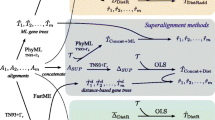Abstract.
The neighbor-joining (NJ) method is widely used in reconstructing large phylogenies because of its computational speed and the high accuracy in phylogenetic inference as revealed in computer simulation studies. However, most computer simulation studies have quantified the overall performance of the NJ method in terms of the percentage of branches inferred correctly or the percentage of replications in which the correct tree is recovered. We have examined other aspects of its performance, such as the relative efficiency in correctly reconstructing shallow (close to the external branches of the tree) and deep branches in large phylogenies; the contribution of zero-length branches to topological errors in the inferred trees; and the influence of increasing the tree size (number of sequences), evolutionary rate, and sequence length on the efficiency of the NJ method. Results show that the correct reconstruction of deep branches is no more difficult than that of shallower branches. The presence of zero-length branches in realized trees contributes significantly to the overall error observed in the NJ tree, especially in large phylogenies or slowly evolving genes. Furthermore, the tree size does not influence the efficiency of NJ in reconstructing shallow and deep branches in our simulation study, in which the evolutionary process is assumed to be homogeneous in all lineages.
Similar content being viewed by others
Author information
Authors and Affiliations
Additional information
Received: 7 March 2000 / Accepted: 2 August 2000
Rights and permissions
About this article
Cite this article
Kumar, S., Gadagkar, S. Efficiency of the Neighbor-Joining Method in Reconstructing Deep and Shallow Evolutionary Relationships in Large Phylogenies. J Mol Evol 51, 544–553 (2000). https://doi.org/10.1007/s002390010118
Published:
Issue Date:
DOI: https://doi.org/10.1007/s002390010118




